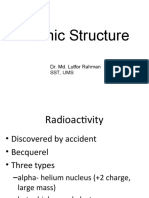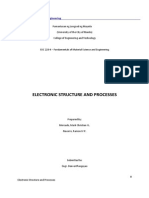0% found this document useful (0 votes)
24 views3 pagesAtomic Structure Notes Part1
The document provides an overview of atomic theory, detailing the contributions of key scientists such as John Dalton, J.J. Thomson, Ernest Rutherford, and Niels Bohr. It explains the structure of atoms, including subatomic particles, atomic models, quantum mechanics, and electronic configuration. Additionally, it introduces concepts like isotopes, isobars, and isotones, along with practice questions for further understanding.
Uploaded by
s21nchem1m01018Copyright
© © All Rights Reserved
We take content rights seriously. If you suspect this is your content, claim it here.
Available Formats
Download as PDF, TXT or read online on Scribd
0% found this document useful (0 votes)
24 views3 pagesAtomic Structure Notes Part1
The document provides an overview of atomic theory, detailing the contributions of key scientists such as John Dalton, J.J. Thomson, Ernest Rutherford, and Niels Bohr. It explains the structure of atoms, including subatomic particles, atomic models, quantum mechanics, and electronic configuration. Additionally, it introduces concepts like isotopes, isobars, and isotones, along with practice questions for further understanding.
Uploaded by
s21nchem1m01018Copyright
© © All Rights Reserved
We take content rights seriously. If you suspect this is your content, claim it here.
Available Formats
Download as PDF, TXT or read online on Scribd
/ 3























































































